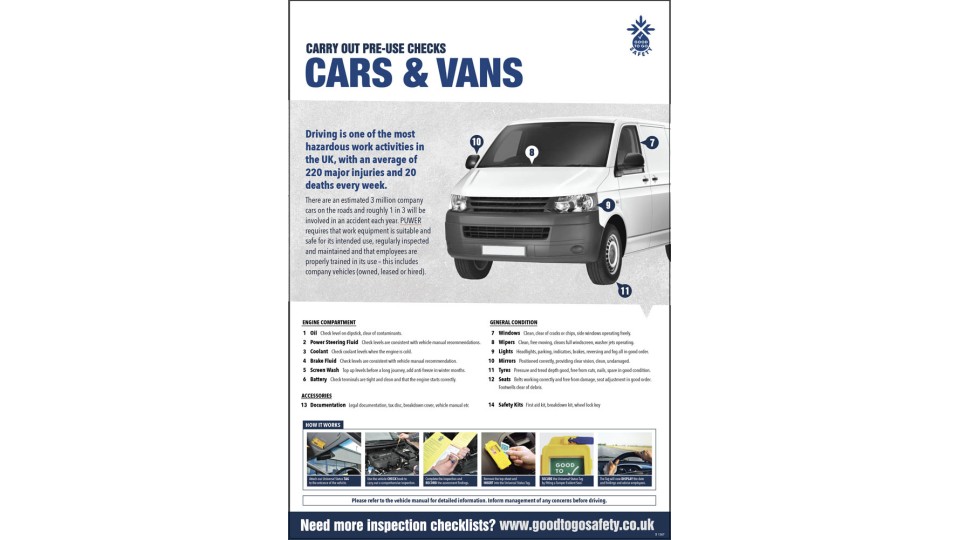The HSE (Health and Safety Executive) have investigated an accident where a HGV driver suffered fatal chest injuries. The driver was unstrapping a load on the flatbed trailer, when the load (steel gates) fell and tragically crushed him. Andrew Bayley-Machin, 41, was fatally crushed after the steel gates fell approximately 10 ft from the trailer.
Do you play the National Lottery? Millions do and, every week, they buy a ticket in the hope of winning the jackpot. Yet the odds of doing that are a vanishingly small 1 in 45 million! And still millions of people think it might be them.
In Great Britain, there are roughly 20 million vehicles driven on business. made up of just under one million company cars, nearly four and a half million vans, 400,000 HGVs and a staggering 14 million private cars thought to be used for work journeys – some every day, some only occasionally.
Every year, according to government statistics, around 40,000 people are injured in collisions that involve someone who was driving for work. Plus, these are only the injuries that are reported – many aren’t. And there are many more that only involve damage to vehicles or property. This means the odds of being involved in an injury collision while driving for work are just 1 in 500 and yet very few people ever believe it will happen to them.
That means if you have a fleet of 500 vehicles you can expect your drivers to be involved in at least one injury collision every year on average. If your drivers and vehicles aren’t managed well, then the odds could be even higher.
Anyone who manages drivers and vehicles has a legal duty of care under the Health and Safety at Work Act to take all ‘reasonably practicable’ steps to minimise the risk to staff, and anyone else who may be affected by the company’s operations.
In short this legislation means that
• The company mustn’t do anything that puts drivers at risk.
• The company’s work-related driving activities mustn’t endanger any other road users.
• Directors must put appropriate policies and procedures in place to ensure that this is so.
• And all employees including drivers, managers and directors must follow those policies and procedures at all times.
The key to success is understanding how these legal responsibilities are shared across the business at all levels:
• Directors and managers have a responsibility to ensure that risks are identified and managed, and that the correct policies and procedures are put in place.
• Your drivers have a responsibility to follow those procedures and behave responsibly at all times, driving safely and following the Highway Code.
• Line managers, work schedulers and others may also have an important role to play in managing the risk, by ensuring that drivers aren’t subject to unreasonable demands that might encourage them to speed or increase the risk of fatigue.
When everyone is aware of their responsibilities, and working together, some of the benefits we can start to see include:
• Drivers being at less risk while out on the road.
• Less chance of the business being judged at fault for any incidents and, therefore, a lower likelihood of the business being exposed to prosecution and heavy fines.
• Reductions in fleet operating costs like insurance, fuel and maintenance costs.
Don’t allow your driver risk management to become a lottery. Knowledge and careful planning are needed to ensure that you, your drivers, other road users and your business are fully protected.
By Simon Turner, Campaign Manager for the Driving for Better Business programme
---------------------------------------------------------------------------------------------------------------------------------------------
At Good to Go Safety and TakeAIM we are a firm believer that both employers and employees shouldn't gamble with their safety. If an employee uses the same car, van, motorbike every day without carrying out routine checks it is easy for them to fall into the trap of assuming that “it was fine yesterday even though it made a few odd noises, I’m sure it will be fine today”. Each day that this assumption continues to be made, so does the false feeling of security, until one day the equipment in question breaks down and/or causes an accident.
The cost of ignoring faults / issues and assuming that everything is / will be ok can be high. Failing to check and properly plan repair undoubtedly leads to vehicle failures which on average costs 3 to 5 times more than preventative maintenance.
That chip in your windscreen, will crack or blow out. That under inflated tyre can separate and blowout. That brake light would of helped the family of four from smashing into the back of you. Your empty screen wash could have helped when the sun lit up your windscreen. There are many things on vehicles which should be checked prior to use.
Both Good to Go Safety and TakeAIM provide a fleet vehicle safety inspections, designed to encourage drivers to carry out essential pre-use vehicle safety inspections of their car or van prior to a journey. These walk round checks can be built into a fleet management policy and help to ensure the safety of the vehicle whilst reducing maintenance costs. Both our paper system and digital system help employers meet their legal duty of care to ensure the safety of staff whilst they work, in accordance with various separate laws governing occupational driving including The Health & Safety at Work Act 1974, PUWER & The Road Traffic Act 1998.
---------------------------------------------------------------------------------------------------------------------------------------------
If you’d like to learn more about what you and your organisation should be doing and whether you have any gaps in your driver risk management, click here. We have a wealth of free online tools and resources to help you understand where your priorities should be to reduce risk, control costs and improve efficiency.
Do you play the National Lottery? Millions do and, every week, they buy a ticket in the hope of winning the jackpot. Yet the odds of doing that are a vanishingly small 1 in 45 million! And still millions of people think it might be them.
In Great Britain, there are roughly 20 million vehicles driven on business. made up of just under one million company cars, nearly four and a half million vans, 400,000 HGVs and a staggering 14 million private cars thought to be used for work journeys – some every day, some only occasionally.
Every year, according to government statistics, around 40,000 people are injured in collisions that involve someone who was driving for work. Plus, these are only the injuries that are reported – many aren’t. And there are many more that only involve damage to vehicles or property. This means the odds of being involved in an injury collision while driving for work are just 1 in 500 and yet very few people ever believe it will happen to them.
That means if you have a fleet of 500 vehicles you can expect your drivers to be involved in at least one injury collision every year on average. If your drivers and vehicles aren’t managed well, then the odds could be even higher.
Anyone who manages drivers and vehicles has a legal duty of care under the Health and Safety at Work Act to take all ‘reasonably practicable’ steps to minimise the risk to staff, and anyone else who may be affected by the company’s operations.
In short this legislation means that
• The company mustn’t do anything that puts drivers at risk.
• The company’s work-related driving activities mustn’t endanger any other road users.
• Directors must put appropriate policies and procedures in place to ensure that this is so.
• And all employees including drivers, managers and directors must follow those policies and procedures at all times.
The key to success is understanding how these legal responsibilities are shared across the business at all levels:
• Directors and managers have a responsibility to ensure that risks are identified and managed, and that the correct policies and procedures are put in place.
• Your drivers have a responsibility to follow those procedures and behave responsibly at all times, driving safely and following the Highway Code.
• Line managers, work schedulers and others may also have an important role to play in managing the risk, by ensuring that drivers aren’t subject to unreasonable demands that might encourage them to speed or increase the risk of fatigue.
When everyone is aware of their responsibilities, and working together, some of the benefits we can start to see include:
• Drivers being at less risk while out on the road.
• Less chance of the business being judged at fault for any incidents and, therefore, a lower likelihood of the business being exposed to prosecution and heavy fines.
• Reductions in fleet operating costs like insurance, fuel and maintenance costs.
Don’t allow your driver risk management to become a lottery. Knowledge and careful planning are needed to ensure that you, your drivers, other road users and your business are fully protected.
By Simon Turner, Campaign Manager for the Driving for Better Business programme
---------------------------------------------------------------------------------------------------------------------------------------------
At Good to Go Safety and TakeAIM we are a firm believer that both employers and employees shouldn't gamble with their safety. If an employee uses the same car, van, motorbike every day without carrying out routine checks it is easy for them to fall into the trap of assuming that “it was fine yesterday even though it made a few odd noises, I’m sure it will be fine today”. Each day that this assumption continues to be made, so does the false feeling of security, until one day the equipment in question breaks down and/or causes an accident.
The cost of ignoring faults / issues and assuming that everything is / will be ok can be high. Failing to check and properly plan repair undoubtedly leads to vehicle failures which on average costs 3 to 5 times more than preventative maintenance.
That chip in your windscreen, will crack or blow out. That under inflated tyre can separate and blowout. That brake light would of helped the family of four from smashing into the back of you. Your empty screen wash could have helped when the sun lit up your windscreen. There are many things on vehicles which should be checked prior to use.
Both Good to Go Safety and TakeAIM provide a fleet vehicle safety inspections, designed to encourage drivers to carry out essential pre-use vehicle safety inspections of their car or van prior to a journey. These walk round checks can be built into a fleet management policy and help to ensure the safety of the vehicle whilst reducing maintenance costs. Both our paper system and digital system help employers meet their legal duty of care to ensure the safety of staff whilst they work, in accordance with various separate laws governing occupational driving including The Health & Safety at Work Act 1974, PUWER & The Road Traffic Act 1998.
---------------------------------------------------------------------------------------------------------------------------------------------
If you’d like to learn more about what you and your organisation should be doing and whether you have any gaps in your driver risk management, click here. We have a wealth of free online tools and resources to help you understand where your priorities should be to reduce risk, control costs and improve efficiency.





